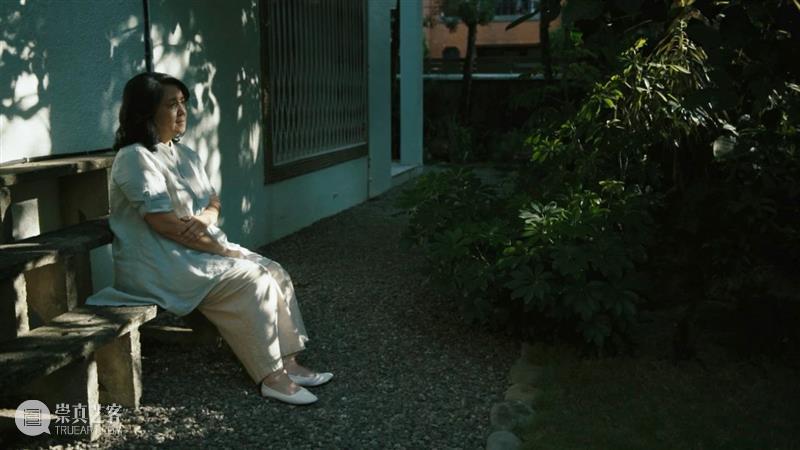
≡ 陶辉 Tao Hui
录像静帧 Video still
南方戏剧史 A 幕
The History of Southern Drama, Scene A, 2018
《南方戏剧史》作家冷水花访谈:
单频道录像,彩色,有声
An Interview with Leng Shuihua, Writer of The History of Southern Drama:
Single-channel video, colour, sound
10 min 46 sec
图片由艺术家,马凌画廊和施博尔画廊提供
Image courtesy of the Artist, Edouard Malingue Gallery
and Esther Schipper Gallery
“自由联接
2020 OCAT x KADIST 青年媒体艺术家展览”
"UN/ CONVENTIOANL
OCAT x KADIST Emerging Media Artist Exhibition 2020""
展期 Duration: 2020.05.16-2020.08.16
地址 Address: OCAT上海馆
上海市静安区曲阜路9弄下沉庭院,负一层
OCAT Shanghai | -1F Sunken Garden, Lane 9, Qufu Road, Jing'an District, Shanghai
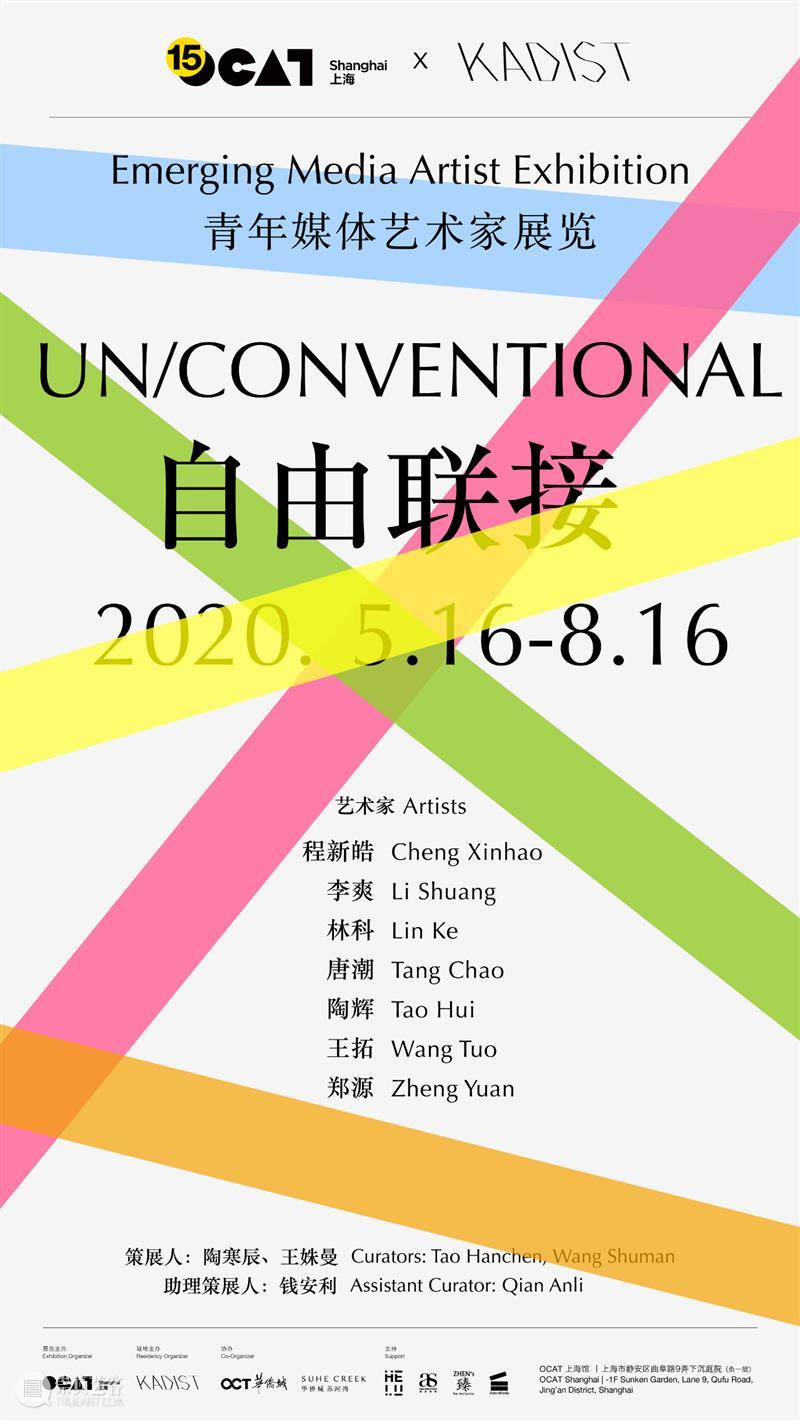
图片由OCAT上海馆提供
Image courtesy of OCAT Shanghai
陶辉受邀参加OCAT上海馆和KADIST艺术基金会合作发起的展览“自由联接”。
OCAT上海馆携手KADIST艺术基金会,联合发起此次展览+驻地项目。作为青年媒体艺术家年度项目的第七次呈现,同时也是在OCAT上海馆新空间的首次亮相,OCAT秉持项目发起的初衷,深化媒体艺术的研究与发展,推动青年艺术家的创作力,扩大媒体艺术的影响力。七位优秀的中国青年媒体艺术家——程新皓、李爽、林科、唐潮、陶辉、王拓和郑源——受邀共同参与本次项目的展览部分;KADIST艺术基金会亦将为项目的后续注入更多的推动力,以多样化的艺术驻地资源给予艺术家更充沛的支持,提供跨文化语境交流与探索的机会。在过去三至五年间,这些艺术家所表现出的活跃创作力和多维度的媒体艺术语言,让我们有机会观察到艺术家个体内部的延续性和差异性,同时也将通过机构展览、艺术家新作委托和策展介入等方式,对艺术家群体所面对的共通问题展开叙述。
在技术媒介日新月异的今天,以影像、装置等作为主要语言的媒体艺术,因技术限制的趋低而被泛化认知,从而使得艺术家对于艺术工作的理解发生了分野,媒体艺术似乎掉入了内卷化的陷阱而重复及停滞不前。但仍然有很多并不以艺术生产为目标的艺术家,展现了他们在社会系统中的多层身份属性:“艺术家”的身份只存在于工作室、展览或艺术创作的语境内。语境之外,他们往往选择以不同的社会角色和身份去介入现实世界,并进行观察、感知、研究和影响。为了回应艺术家身份的有效性问题,本次展览将在空间中打乱艺术家个体的单独体系,以“自由联接”为形式,展现艺术家自我赋予的社会属性。艺术家们进行的“角色扮演”——从地质调查员到社会运动实践者;从视频博客的自述者到重构新闻事件的编导者等等——其所活动的场域仿若一个巨大的乐园,并呈现出一种莫比乌斯环式的拓扑结构:艺术家和作品如同是带有两面完全独立的个体。而在“莫比乌斯”的融合性下,渐生出在相同时代及地域背景下某种形式上的共性,并又因互相间不同生活体验和创作视角,衍生出无限发生的另一特质。此外,艺术家还将受邀“扮演”策展人的角色,携委托新作在展览途中介入,最终在美术馆空间内达成一种自治及共存的状态。
——文字来源于OCAT上海馆
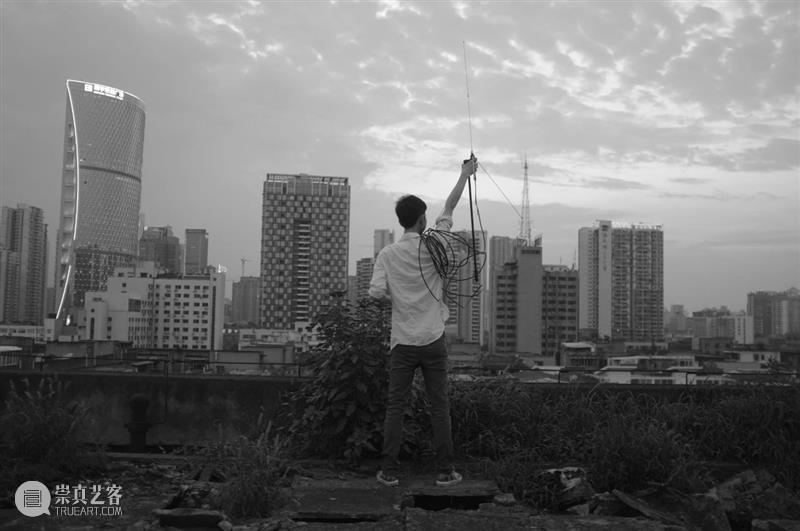
≡ 陶辉 Tao Hui
观光客 Sightseers, 2013
综合媒介 Mixed medium
尺寸可变 Dimension variable
图片由艺术家,马凌画廊和施博尔画廊提供
Image courtesy of the Artist, Edouard Malingue Gallery
and Esther Schipper Gallery
Tao Hui is invited to participate in the group show "UN/ CONVENTIOANL", presented by OCAT Shanghai and KADIST.
OCAT Shanghai collaborates with KADIST in launching this exhibition and artist residency project. For the seventh edition of our endeavor, marking the first presentation at the new OCAT Shanghai venue, OCAT's unwavering initial intent for this project continues to push OCAT in deepening the research and development for media art, promoting young artists' practice, and expand the impact of media art. Seven outstanding emerging media artists, who are Cheng Xinhao, Li Shuang, Lin Ke, Tang Chao, Tao Hui, Wang Tuo, and Zheng Yuan, are invited to participate in the exhibition section of this project. KADIST will also offer extensive promotions to this project, by providing diverse artist residency programs and resources to the artists, and an opportunity for exchange and exploration in a cross-cultural context. Over the last three to five years, these artists have shown exhilarating creativity and command for the language of media art in multiple dimensions. Their works allow us to observe the continuation and variations in an artist's practice, at the same time, through their exhibitions at various art institutions, commissioned projects, and curatorial interventions for our grasp of the issues they confront and the expanded narratives.
As today’s technology and media bring about new changes, media art dominated by artistic languages such as moving images and installation is understood in general due to its low requirement for technology that diverges the artists' understanding of art practice. Art media seems to have fallen into the trap of involution with repetition and stagnation. However, there are many artists whose goal is not artistic production, presenting their multiple identities in the social system: the role of the artist only exists in the contexts of the artist's studio, art exhibition or art practice. Beyond these contexts, they often choose other social roles and identities to engage in the real world scene, observe, perceive, study, and make impacts. To extend the discussion of the effectivity of the artist’s identity, this exhibition will not follow the conventional model of presenting an individual system of an artist's practice in its exhibition space, but to take on a "un/conventional" approach in presenting the artists' self-assigned social attributes. Artists carry out various types of "role plays" – from geological surveyor to social movement practitioner, from vlogger to editor of a reconstructed news event – the site of their activities is like a giant amusement park, showing a Mobius ring-like structure: where the artist and the artworks become two entirely independent entities. Under the integrated "Mobius," certain formal commonalities engender gradually under the same time and regional background, while their varying life experiences and creative angle derive alternative qualities that unfold infinitely. Moreover, the artist will be invited to "play" the role of the curator and commission new works that will intervene during the exhibition, to eventually achieve an autonomous and co-habitation state at the art museum.
- Text from OCAT Shanghai
“梦饮酒者”
"Wake Up Crying""
展期 Duration: 2020.05.21-08.10
在线电影院 Online screening exhibition
链接:https://5ynjqq.epub360.com.cn/v2/manage/book/ar5v01/?from=timeline&isappinstalled=0
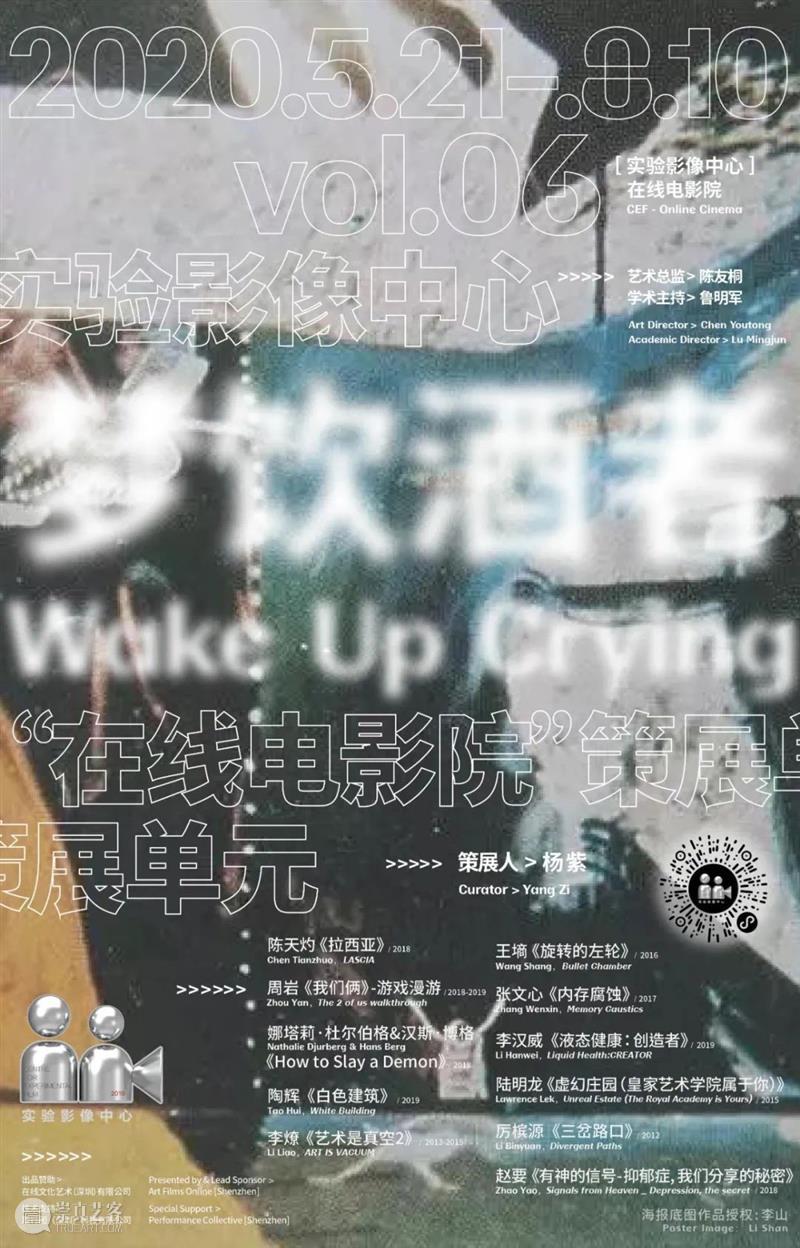
(长按识别图中小程序码即可观看)
图片由实验影像中心提供
Image courtesy of Centre for Experimental Film
实验影像中心第六期“在线电影院”策展单元“梦饮酒者”由杨紫策划,选择了12位艺术家的作品。陶辉的《白色建筑》(2019)正在放映。
基于移动端特征与时代条件,实验影像中心借用线下院线的机制以及重启观影仪式,定时定点的上映和下架影片。同时推出系列专题展映的策划单元,通过在线影像呈现给观众,同时也将逐步优化与线下放映设备的同步与快捷连接,驱动影像不同维度呈现的可能性。
——文字来源于实验影像中心
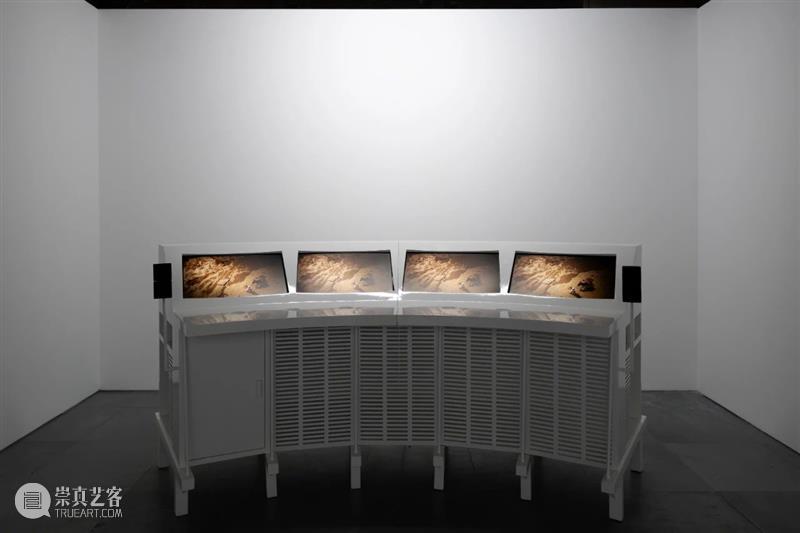
≡ 陶辉 Tao Hui
白色建筑 White Building, 2019
录像装置,有声,木材,屏幕,音箱
Video installation, sound, wood, LED screen, speaker
124 x 286 x 130 cm
图片由艺术家和马凌画廊提供
Image courtesy of the Artist and Edouard Malingue Gallery
The online screening exhibition "Wake Up Crying" is produced by CEF and curated by Yang Zi. The exhibition exhibits 12 artists' video works. Tao Hui's White Building (2019) is currently on view.
Given the attribution of mobile terminal in our era, CEF transforms a series of offline or physical cinema mechanism, such as movie watching ceremony, a specific time slot, spot and on-and-off screening schedule to be online. In addition, it curates series of themed screening units and presents them to audience on line. On the other hand, CEF interacts with physical cinema and strives to optimize offline facilities for a fast connection or even sync, actuating film presenting in various possible dimensions.
- Text from CEF
“宫津大辅25年录像收藏展:
东亚与东南亚的境迁信号”
"Daisuke Miyatsu:
25 years of video art
- A point of transit signals from East and South East Asia""
展期 Duration: 2020.05.22-2021.01.03
地址 Address: 金马宾馆当代美术馆
804 高雄市鼓山区鼓山一路111号
Alien Art Centre, No.111, Gushan 1st Rd., Gushan Dist., Kaohsiung City
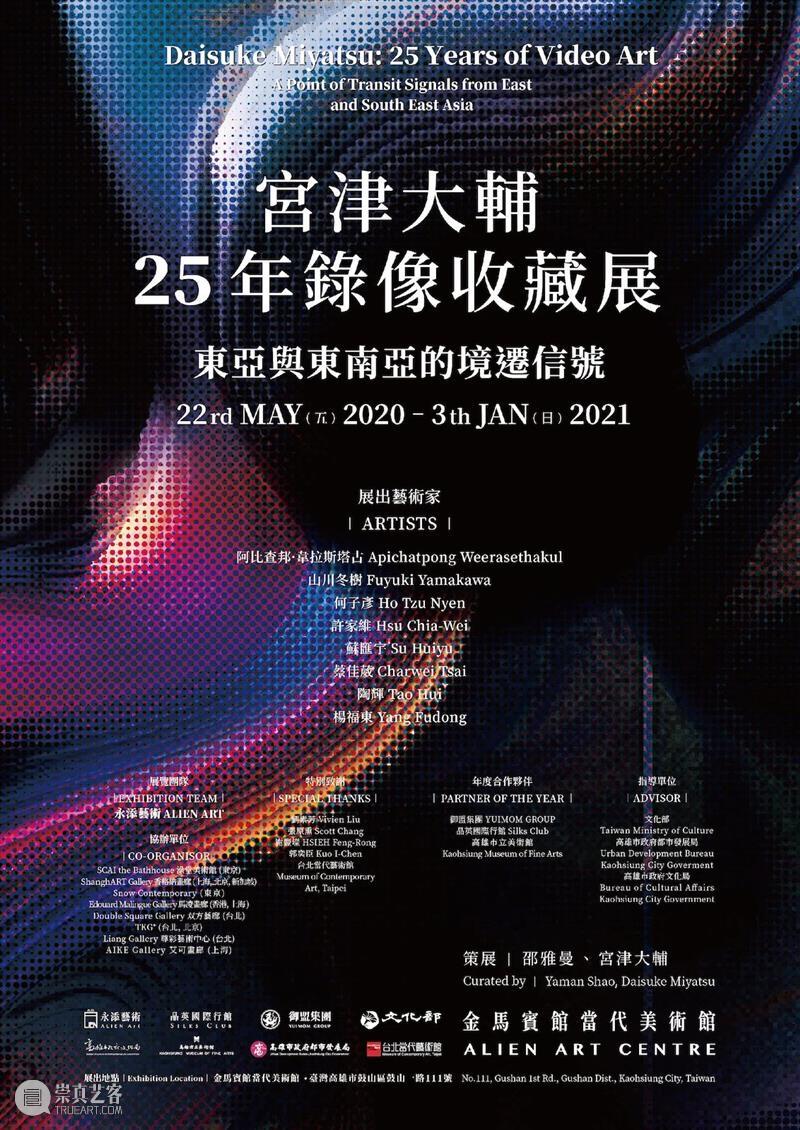
图片由金马宾馆当代美术馆提供
Image courtesy of Alien Art Centre
陶辉的作品《德黑兰的黄昏》(2014)正在“宫津大辅25年录像收藏展:东亚与东南亚的境迁信号”展出。
事实上我们对于时间运用的认知,逐渐缺乏耐性,而录像艺术,游移在剧场与艺术范畴之间,改变了人们通俗的阅读方式,引领我们探究更丰富的感官经验,于此,艺术跨领域的结合与蜕变,是现代人的福音。600年前荷兰画家因地理与生活条件而发明了油彩,而今科学的跃进带来了录像媒介,之于生处在现代的我们,如何理解这个领域,转化视觉阅读做为睿智的行动,是我们与时演进的课题。
在一个漫谈的过程中,宫津大辅提及他对于录像的着迷。这个理想能够成真,某个程度上,是源自朋友之间的承诺。在这纷乱的时刻,本能地希望,这种对于艺术的热忱、关注与支持,能够点燃一些希望的火花。一切看似遥远,其实,正成为我们生活的主轴。2020年是一个特殊的年份,这个震荡让我们看见世界更真实的一面,以及种种虚幻。而在这样的时刻,一场跨国团队合作的展览,令我们感受到人与人之间的紧密连结不分国界。在种种行为选择发生在虚拟世界的途中,我们看见录像艺术的巨大潜能所构成的悖论。它来自数位的编写,却向我们说明“场域”无可被取代的意涵。
在宫津先生25年共逾100件录像收藏中,最终我们筛选出8位东亚艺术家的经典作品,作为宫津先生,对于亚洲美术史之时空观的传媒代表。艺术家来自泰国、新加坡、日本、台湾与中国,从宗教经典、国史、声像、梦境与文化限制,回到对于多样性社群最需被重视的议题与环境认知。从东方美学的时空观点,我们看见关于现在与过去的边界所产生的诗性空间,在所有困顿中所潜藏着转机与启示。这些造就我们的丰富性,曾经我们以为匮乏。
高雄,做为海纳百川的自由之城、台湾的国际转运枢纽,本期展览,希望能带给您更多对于亚洲文化视觉语言的开阔与想像。
——文字来源于金马宾馆当代美术馆,由永添艺术执行长邵雅曼撰写
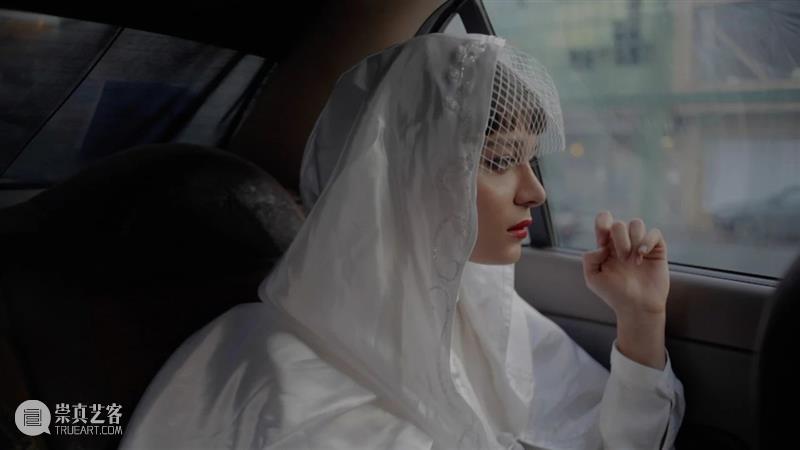
≡ 陶辉 Tao Hui
录像静帧 Video still
德黑兰的黄昏 The Dusk of Teheran, 2014
单通道彩色有声高清录像
Single-channel video, color, sound
4 min 14 sec
图片由艺术家,马凌画廊和施博尔画廊提供
Image courtesy of the Artist, Edouard Malingue Gallery
and Esther Schipper Gallery
Tao Hui's The Dusk of Teheran(2014) is exhibited in "Daisuke Miyatsu: 25 years of video art - A point of transit signals from East and South East Asia".
In reality, we are gradually lacking patience regarding our understanding on using time. As for video art, given that it wobbles between theatre and art, it has changed the people’s common way of reading, guiding us into a more abundant sensual experience. Therefore, the trans-field combination and transformation of art is a gospel for modern people. Dutch artists invented oil painting 600 years ago due to geographical and living circumstances, while modern scientific improvements brought about video media. How can we, living and raised in the modern era, understand this field and transform visual reading into wise actions, is a time-evolving issue for all of us.
In a casual conversation, Daisuke Miyatsu talked about his fascination to video art. The fact that this fascination could be turned into exhibition, is more about realising a promise between friends. In chaotic times, instinctively we hope that, the passion of care and support to art, could sparkle something in the darkness. All these seem very far away from our daily, but in fact, have become the core of our reality. 2020 is a year that reveals the actualities of the world, and also the numerous illusions. In this specific moment, a global united effort in realization of this exhibition verifies the tight connections between nationalities would not be distanced by borders. While activities have been transformed into the virtual world, we witness the paradox situation led by the potentiality of video art. By digital coding, it conversely evidences a “place” is irreplaceable.
Out of the more than 100 videos collected by Mr. Miyatsu in the past 25 years, we have selected 8 classical works by East Asian artists as media representatives of Mr. Miyatsu’s perspective on the Asian history of art. These artists come from Thailand, Singapore, Japan, Taiwan and China. They presented issues that required more attentions from versatile social communities and environmental understanding from the perspectives of religious classics, national history, acoustic image, dreams and cultural restrictions. From the eastern aesthetic perspective of space and time, we discover the poetic place in between the border of the now and the past. But it no longer remains as metaphors, it reveals the opportunity from the frustration. These richness within the things that make us, we used to perceive as deficiency.
Kaohsiung, as an accepting city of freedom and the international transportation hub of Taiwan, we expect to give you more openness and imagination on the visual language of Asian cultures through this exhibition.
- Text from Alien Art Centre, written by Yaman Shao.
“具身之镜
中国录像艺术中的行为与表演”
"Embodied Mirror:
Performances in Chinese Video Art""
展期 Duration: 2020.05.22-2020.08.30
地址 Address: 新世纪当代艺术基金会
北京朝阳区798艺术区797东街A05
No. A05, 797 East Road, 798 Art Zone, Chaoyang District, Beijing
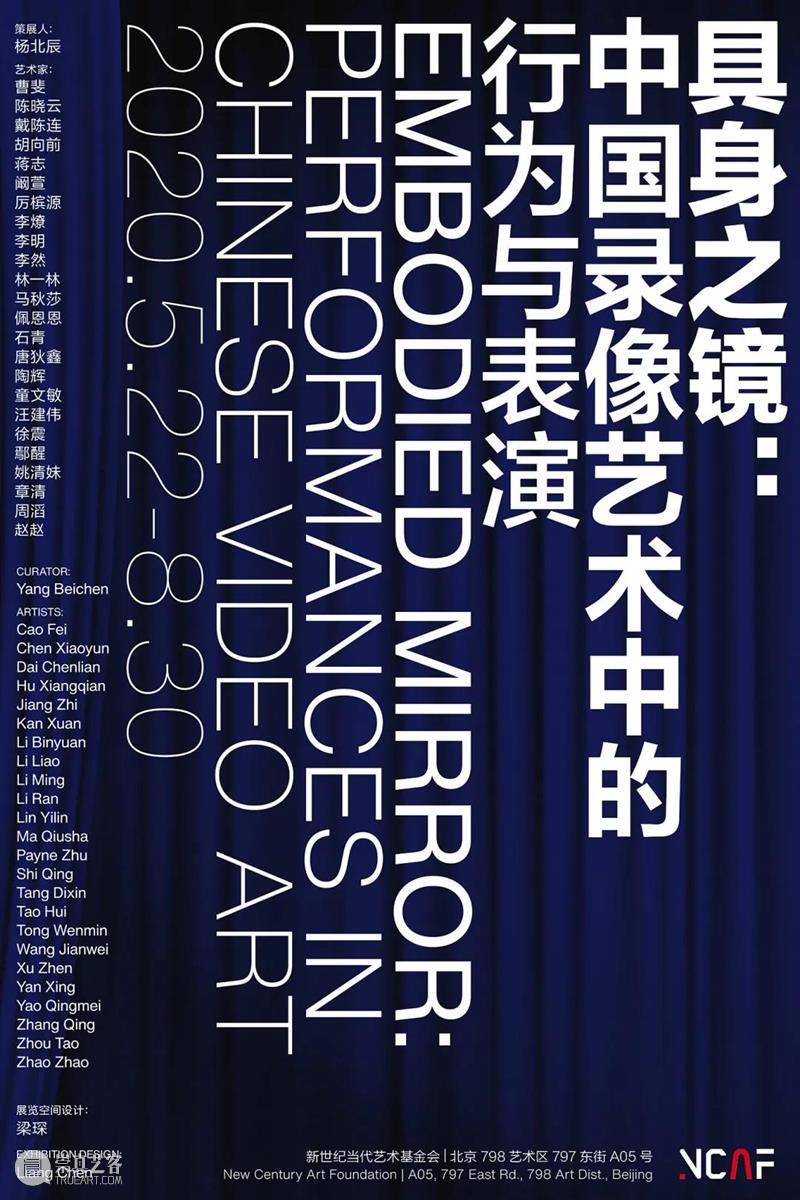
图片由新世纪当代艺术基金会提供
Image courtesy of New Century Art Foundation
在费伦这样的表演原教旨主义者眼中,表演一旦沦为图像再生产的对象便会彻底堕落,这背后自然有第二次前卫艺术运动所宣扬的“去物质化”立场——认为媒体与资本主义同构——只不过这种意识形态在新的媒介现实面前多少显得不堪一击。自1960年代开始,表演便逐步与媒体艺术相结合,在现场经验与再生产、呈现与再现间摆荡,进而我们发觉,如今被称为经典的“行为艺术”,往往都以某种媒介化的形式得以留存。录像艺术无疑是其中极为重要的一环。录像化的表演或表演性的录像衍生出了多种复杂的形态,身体与技术的互动将两种不同的话语糅合在一起,有机与人工、即时与纪录、肉身与屏幕不可避免的发生着摩擦与交融。而这正成为了本次展览的出发点。
“具身之镜”试图探讨的即是在中国当代艺术的历史中,录像艺术与表演之间展开的密集交流。中国录像艺术的开端便与表演相关,在张培力1988年的作品《30x30》中,我们得以管窥摄影机在时间流逝中对于身体的客观观察,及其形成的极具冲击力的寓言式效果。在之后中国录像艺术的发展中,不断有艺术家采取策略化的方式,将录像与表演设置为互为延展的领域。整个展览被划分为五个主题:“自传”、“事件”、“舞者”、“演讲者”与“剧场”。每一个主题都涉及一条独立的线索,以梳理这个交叉地带中纷繁复杂的现象。陶辉将展出作品《谈身体》(2013)。
“具身之镜”指向了这样一个事实,即录像并没有为表演带来新的“舞台”,而是一个通往世界的“镜面”或“出口”;其作用亦并非仅仅在于解放身体,或令其摆脱社会与历史语境的规约,而是提供了新的战术装置或解码器:影像化的身体如同一个“不朽的”与“可传播”的化身,在这种情境中,媒介呈现为崭新的生命情景,而主体对于现实的回应已被转化为共通的媒介感知。

≡ 陶辉 Tao Hui
录像静帧 Video still
谈身体 Talk About Body, 2013
单频录像,彩色,有声
Single-channel video, color, sound
3 min 45 sec
图片由艺术家,马凌画廊和施博尔画廊提供
Image courtesy of the Artist, Edouard Malingue Gallery
and Esther Schipper Gallery
In the eyes of a performance fundamentalist like Phelan, once this medium degrades to the object of reproduction of images would be fully degenerate. Behind this, one would likely find its supporting position of "dematerialization," advocated by the second avant-garde art movement. Where the medium is isomorphic to capitalism – only that such ideology seems somewhat flimsy before the realities of a new medium. Since the 1960s, performance became integral to media art, in the swings of live experience and reproduction, presentation and representation, we come to realize that what was once referred to as the classic "performance art" often preserved in a mediated form. Video art is undoubtedly one of the critical loops. Recorded performance or performance videos derived into many complicated forms, the interactions between the body and technological media bring together two different types of discourse, where the organic and the artificial, the immediate and the documentary, the flesh and the screen generate unavoidable friction and integration. These are the points of departure for this exhibition.
What “Embodied Mirror" attempts to explore is the intimate exchange between video art and performance in the history of Chinese contemporary art. At its inception, video art in China was integral to performance art. With time passing through the camera lens, Zhang Peili’s 30 x 30 (1988) allowed the viewer to observe the body objectively, from which to arrive at the impact of its metaphorical effects. Thereon, in the development of video art in China, many artists have adopted strategic approaches to extend the mediums of video art and performance for one another. This exhibition presents five themes, "Autobiography," "Event," "Dancer," "Speaker," and "Theater." Each topic will address an independent clue in combing through the diverse and complex phenomenon of this overlapping domain. On view is Tao Hui's Talk About Body (2013).
“Embodied Mirror" points to the fact that video art does not necessarily provide the "stage" for performance, but a "mirror" or "exit" to access the world. It does not necessarily emancipate the body or to isolate it from the confines of social and historical discourses, but provides new strategic device or decoder. Where the body becomes the embodiment of "eternity" and "transmission" in the context of moving image, and the medium becomes a new scenario of life. At the same time, the subject's response to reality translates into a shared media sensibility.
- Text from New Century Art Foundation, written by Yang Beichen
艺术家简介 About the artist
陶辉1987年出生于重庆云阳,毕业于四川美术学院的油画系,现工作生活于北京。虽然毕业于油画系,但陶辉的作品以影像和装置艺术为主,从个人记忆、视觉经验和大众文化中积累素材,通过提炼与改造形成崭新的叙事模式和影像风格。陶辉从社会身份、性别地位、种族问题和文化危机等问题入手,以荒诞、吊诡、夸张的场景搭建,充满隐喻和错位感的人物设置,呈现出当代人的集体经验,带动观者正视自身的文化历史、生存现状和社会身份。他曾于2008年获得四川美术学院的“当代艺术档案特殊奖”,并在2015年荣获三亚艺术季华宇青年奖评委会大奖。2015年陶辉在SESC巴西录像艺术节“南部全景”单元上获得特奖,又于2017年先后入选HUGO BOSS亚洲新锐艺术家大奖和KINO DER KUNST电影节“国际竞赛”单元。2019年,他入围首届由香港M+展亭成立的希克奖。他的个展包括:OCAT西安馆的“一点儿不多余”(2017)和北京尤伦斯当代艺术中心的“新倾向:陶辉”(2015)。参加的群展包括:国立亚洲文化殿堂(ACC)群展(2019);罗马当代艺术博物馆的“SESC巴西录像艺术节影像展”(2019);第四届温哥华双年展"re-IMAGE-n"(2019);上海外滩美术馆和Para Site艺术空间的”百物曲“(2019);上海当代艺术博物馆的第11届上海双年展“何不再问”(2016年);巴黎路易威登基金会的“本土:变革中的中国艺术家”(2016);上海K11基金会的“骇客空间”(2016);圣保罗SESC巴西录像艺术节“南部全景”单元(2013)。
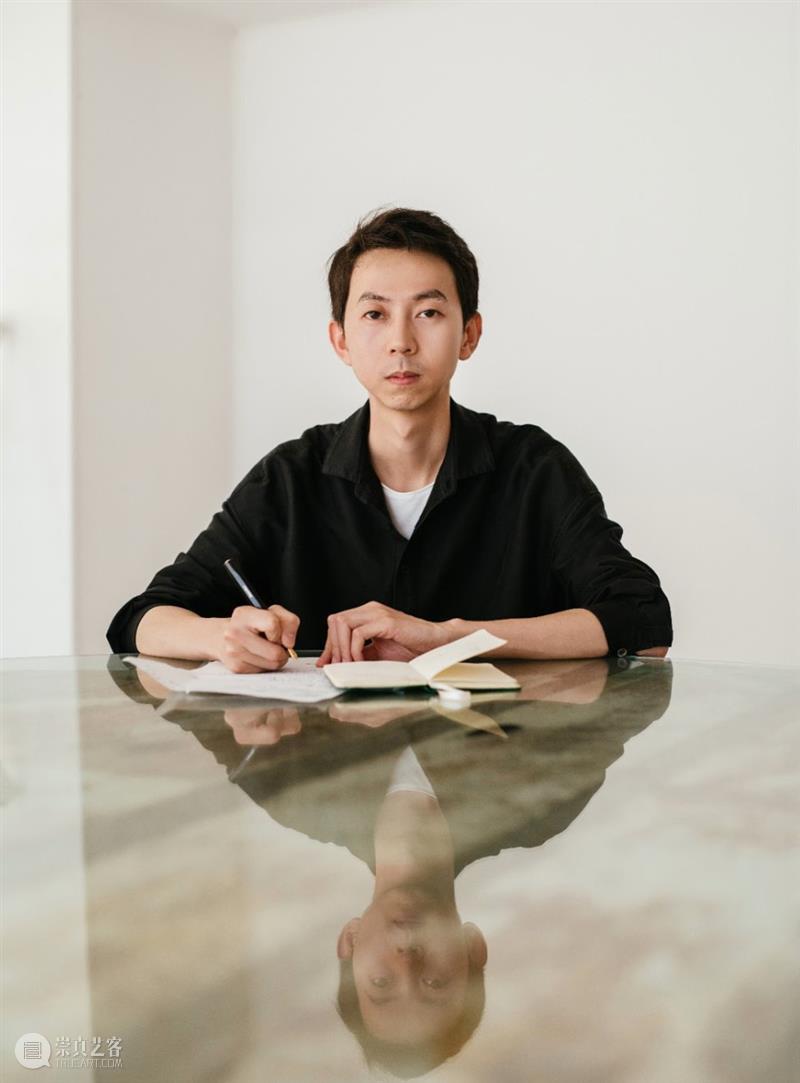
图片由艺术家,马凌画廊和施博尔画廊提供
Image courtesy of the Artist,
Edouard Malingue Gallery
and Esther Schipper Gallery
Tao Hui was born in Yunyang, Chongqing, China. He graduated from Sichuan Fine Arts Institute with a BFA in Oil Painting in 2010 and currently lives and works in Beijing, China. Tao traversed into the art of video and installation, drawing from personal memories, visual experiences and popular culture to weave an experimental visual narration, the focus of which is often our collective experience. Running throughout his work is a sense of misplacement vis-à-vis social identity, gender status, ethnicity and cultural crisis, prompting the audience to face their own cultural histories and living conditions. He won the special award of Contemporary Art Archive from Sichuan Fine Arts Institute in 2008 and ‘Art Sanya & Huayu Youth Award’ in Sanya in 2015. He also won the grand prize of 19th “Contemporary Art Festival Sesc Videobrasil”, and was shortlisted for “HUGO BOSS ASIA ART Award for Emerging Asian Artists” and International Competition sector of the KINO DER KUNST festival in 2017. In 2019, he is shortlisted for the inaugural Sigg Prize. His solo exhibitions include OCAT Xi’an, Xi’an, China, 2017; UCCA, Beijing, China, 2015. Group exhibitions include Asia Culture Center(ACC) group exhibition, Gwangju, Korea, 2019; ‘Collezione Videobrasil, Opere Vincintrici Del Contemporary Art Festival Sesc_Videobrasil’, MACRO ASILO, Rome, Italy, 2019; ‘re-IMAGE-n’, the 4th Vancouver Biennale, Vancouver, Canada, 2019; ‘An Opera for Animals’, Rockbund Art Museum, Shanghai, China / Para Site, Hong Kong, China (2019); 11th Shanghai Biennale’, PSA, Shanghai, China, 2016; Fondation Louis Vuitton, Paris, France, 2016; chi K11 Art Space, Shanghai, China, 2016; ‘Contemporary Art Festival Sesc Videobrasil: Southern Panoramas’, São Paulo, Brazil, 2013, 2015.
正在展出 CURRENT EXHIBITION:
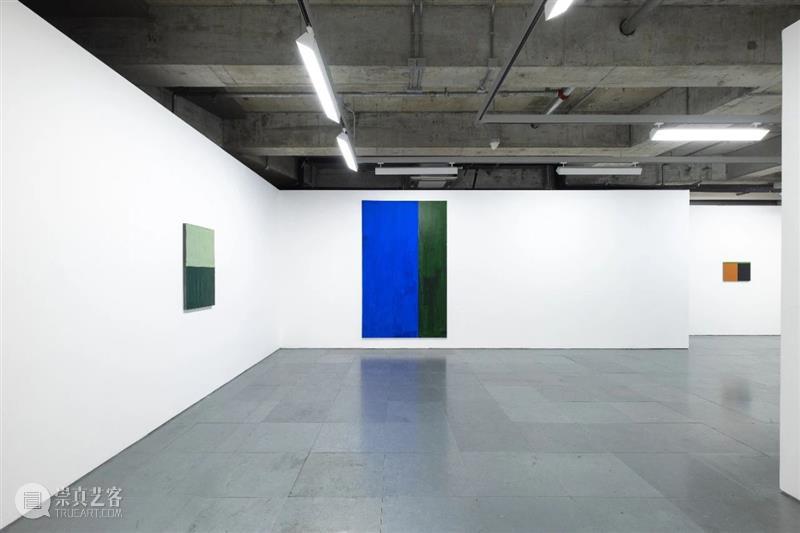 | 香港 Hong Kong “1986 - 1992” 冈瑟·弗格 Günther Förg 20.05.08-05.23 |





















 分享
分享